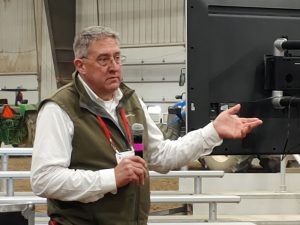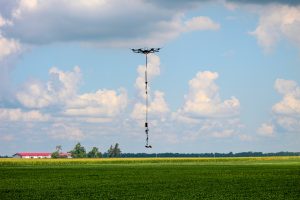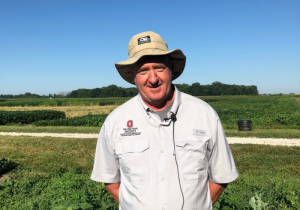Homepage Slider, New Uses, Precision Technology
Agriculture’s Big Picture Through Smaller Pictures
By Dusty Sonnenberg, CCA, Ohio Field Leader: a project of the Ohio Soybean Council and soybean checkoff.
The use of unmanned aerial vehicles, (UAV’s), otherwise known as drones, for aerial imagery in agriculture provides information to farmers to make management decisions. “Historically, the best use of this technology has been to fly fields, and take multiple images, and then when the drone lands, images are downloaded and stitched together and provide the farmer with a single image of the entire field,” said Dr. Scott Shearer, Professor, and Chair of the Department of Food, Agricultural and Biological Engineering at The Ohio State University. “The image is a nice overview of what is going on in the field, and a very cost-effective way to get remote sensing photos. The question is how the farmer uses that image to manage the crop.”
Farmers need data that leads to decisions they can take action on. “We need to be able to turn around in a short amount of time after the drone flies, and put actionable information into the hands of the farmer,” said Shearer. “The further you get away from the flight time, the less valuable that information is for the farmer to make a timely decision.”

Crop scouts play an important role in providing valuable information to farmers regarding a crops’ condition, and information about what is going on in a field. The greatest limitation scouts face is the time it takes to cover large amounts of acres to get a representative sample of what is going on in the field. “We decided to start by working with the crop scouts to find ways we could help make them more effective,” said Shearer. “As the growing season goes on and the crop gets bigger, it becomes more difficult for the crop scout to get across the field. What scouts typically provide is information about what is going on within the crop canopy. Traditional aerial imagery is not able to provide this. It only captures what is going on at the top of the canopy.”
Crop stress such as disease pressure, insect feeding, and other stresses often begin down within the canopy first. To enable a drone to take pictures within the canopy some modifications needed to be made. “We attached what we call a stinger (fiberglass rod) to the bottom of the drone and suspended a camera from it so we could get it down into the canopy to get our images. A lot of the signs of crop stress occur within the canopy,” said Shearer. “Historically the drones have always flown above the canopy and given us images from above, but now we found a way to get images from within the canopy.”
The most recent project now entails flying the drone, capturing the images, and providing the management response information in near real-time. By using Graphical Processing Units (GPU’s) researchers are able to process images in near real-time, while the drone is flying, and generate actionable information using artificial intelligence. “Artificial Intelligence (AI) is able to detect repeated patterns within images and then extract them and match them up with things that are occurring in the field,” said Shearer.
Taking action on the information generated is the next step.

“There is a lot of interest in using drones for making spray applications. The limitation, without obtaining exemptions from the FAA, is that we can only fly up to a 55 pound drone. By the time you calculate the weight of the product, boom, pump and tank, combined with the drone, you are only able to carry at most, 2-3 gallons of product,” said Shearer. “While 2-3 gallons of product cannot go very far in treating a commercial farm field, it could be used to spot-treat areas of concern.”
With funding through a grant from the Ohio Soybean Council, Dr. Shearer along with Dr. Mark Loux, OSU Extension State Weed Specialist, began looking at how this technology, even with its payload limitations, could be beneficial to Ohio’s farmers. “We determined that if we could detect single plants or small patches of glyphosate resistant weeds that survive a typical herbicide program in time to prevent them from going to seed, we could prevent them from developing into bigger infestations and larger problems.” said Shearer.